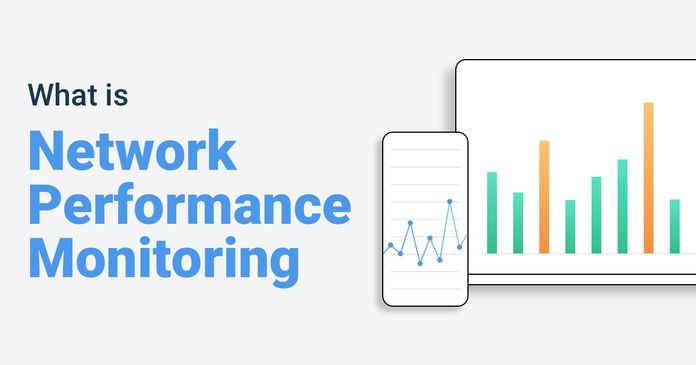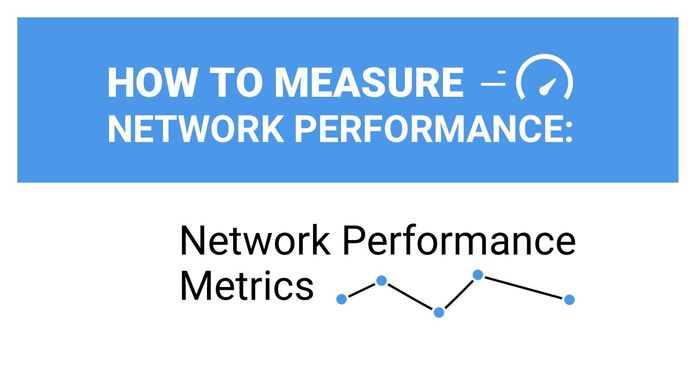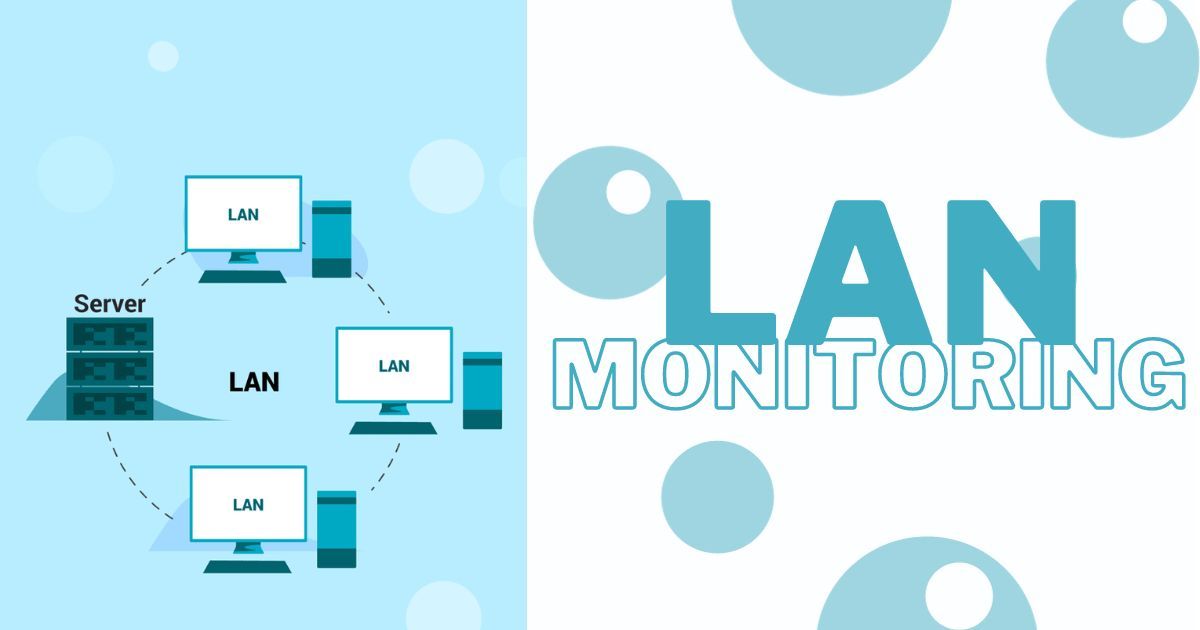Table of Contents
Table of Contents
In an era defined by the relentless pace of digital transformation, the Wide Area Network (WAN) has emerged as the unsung hero of connectivity. With organizations expanding globally, remote work becoming the norm, and data flowing like a digital river, the WAN is the backbone that keeps the modern world interconnected. Yet, as the demand for high-performance, reliable, and secure WANs skyrockets, so do the challenges that network administrators face.
If you've ever wondered how to keep your WAN performing at its best, you're in the right place. In this blog post, we will explore the critical role of WAN monitoring in turbocharging WAN performance. By harnessing the power of real-time data insights, diagnostics, and analytics, organizations can unlock the full potential of their WAN infrastructure.
From reducing latency and downtime to optimizing bandwidth and security, we'll delve into the practical strategies and cutting-edge tools that will empower you to master your WAN and keep it running at peak efficiency.
Whether you're an IT professional striving to meet the ever-increasing demands of your network or a curious enthusiast looking to understand the magic behind seamless global connectivity, this blog post will be your essential guide to navigating the world of WAN monitoring.
Before we dive into the ocean of WAN monitoring, let's all make sure we’re on the same page.
A WAN, or Wide Area Network, is a network that extends over a large geographical area, typically spanning multiple cities, states, countries, or even continents. It is designed to connect and facilitate communication between devices, networks, and systems that are geographically dispersed. WANs are essential for enabling organizations to establish connections between their various locations, branches, or remote sites, as well as for facilitating global data exchange.
Common use cases for WANs include connecting remote offices, data centers, cloud services, and supporting applications that require low latency and high bandwidth, such as video conferencing and real-time data sharing. WANs play a critical role in enabling the global connectivity that underpins modern business operations and communication.

To fully grasp the significance and functionality of WANs, it's imperative to explore the key characteristics and components that underpin their design and operation. As we delve into this section, we will unravel the fundamental building blocks of WAN networks and uncover the core features that empower them to transcend the limitations of distance, ensuring seamless connectivity and data exchange on a grand scale
Key characteristics and components of a WAN network include:
- Geographic Scope: WANs cover a broad area, often on a regional, national, or international scale. They may utilize various transmission mediums, including fibre optics, satellite links, or wireless connections, to bridge long distances.
- Public and Private Infrastructure: WANs can be built using both public and private infrastructure. Public WANs, like the Internet, are accessible to anyone, while private WANs are restricted to specific organizations and are typically more secure.
- Interconnected LANs: WANs connect Local Area Networks (LANs) in different locations. LANs are smaller, localized networks within a single building, campus, or site. WANs enable communication and data sharing between these LANs, fostering collaboration and resource sharing.
- High Bandwidth and Reliability: WANs are designed to handle high volumes of data traffic and provide reliability and redundancy to ensure continuous connectivity. This is crucial for organizations that rely on WANs for mission-critical operations.
- Protocol and Standards: WANs use a variety of networking protocols and adhere to international standards to ensure compatibility and interoperability. For example, the Internet Protocol (IP) is commonly used for data transmission across WANs.
- Security Measures: Security is a top priority for WANs, given the potential for data breaches and cyber threats. Various security mechanisms, such as encryption, firewalls, and virtual private networks (VPNs), are employed to protect data in transit.
- Managed by Service Providers: Many organizations rely on WAN service providers to manage and maintain their WAN infrastructure. These providers offer services like dedicated leased lines, MPLS (Multiprotocol Label Switching) connections, SD-WAN (Software-Defined Wide Area Network) and Dual-WAN solutions to enhance WAN performance and security.
In today's digitally driven world, the performance of a Wide Area Network (WAN) is a make-or-break factor for organizations across the globe. The WAN serves as the information highway that connects geographically dispersed offices, data centers, and remote users. The importance of WAN performance can be understood from various angles:
User Experience:
A high-performing WAN ensures a seamless user experience. Whether it's employees accessing critical applications, customers engaging with your online services, or partners collaborating on shared projects, slow or unreliable WAN connections can lead to frustration, decreased productivity, and potentially even customer churn.
Global Reach:
In an interconnected world, businesses often have a global reach. WANs enable international expansion and support data sharing and communication across continents. They play a pivotal role in keeping multinational enterprises connected.
Data Transfer:
WANs are responsible for the timely and secure transfer of data. This is especially crucial in sectors like finance, healthcare, and manufacturing, where real-time data exchange and collaboration are mission-critical.
Scalability:
As organizations grow, their WAN requirements evolve. Ensuring that a WAN can scale to meet increasing demands is vital. It should be able to accommodate new sites, users, and services without compromising performance.
Learn about network performance monitoring to optimize network performance. Discover key network metrics, tools & techniques & the benefits for businesses.
Learn more

Effective WAN monitoring is the cornerstone of optimizing and maintaining WAN performance for a multitude of reasons. In addition, it goes beyond just optimizing WAN performance, and can also help LAN performance, network devices, cloud services and more.
- Real-Time WAN Insights: WAN monitoring provides real-time visibility into network performance. It allows IT administrators to track metrics like bandwidth utilization, latency, packet loss, and jitter. By having access to this data, organizations can proactively address issues and make data-driven decisions to enhance network performance.
- ISPs and Third-Party Services: WAN monitoring enables you to detect issues with your Internet service providers (ISPs) or third-party cloud service providers. By tracking the performance of external services, you can hold providers accountable for service-level agreements (SLAs) and ensure you are getting the performance you are paying for.
- Diagnostics and Troubleshooting: When performance issues arise, WAN monitoring tools can pinpoint the root causes. Whether it's a congested link, a faulty router, or a misconfigured device, these tools help IT teams diagnose and troubleshoot problems quickly, reducing downtime and disruption.
- Capacity Planning: WAN monitoring assists in network capacity planning by revealing trends and patterns in network traffic. It enables organizations to make informed decisions about bandwidth upgrades, network optimization, and resource allocation.
- Network Traffic Analysis: WAN monitoring provides in-depth traffic analysis, helping you understand the patterns of data flow within your network. This insight is invaluable for optimizing traffic routes, ensuring efficient data transmission, and identifying any potential bottlenecks.
- Service-Level Assurance: For organizations relying on WAN connections to deliver services to clients or users, monitoring is essential for guaranteeing service-level assurance. It ensures that services meet predefined performance standards, resulting in a positive user experience and maintaining the organization's reputation.
- Cloud Adoption: As more organizations embrace cloud services, WAN monitoring becomes vital for tracking the performance and reliability of these cloud connections. It allows you to monitor the impact of cloud applications on your network and optimize their performance.
- VoIP and Video Conferencing: For organizations using Voice over Internet Protocol (VoIP) and video conferencing solutions, WAN monitoring is essential for maintaining high-quality communication. It helps identify and resolve latency, jitter, or packet loss issues that can affect the clarity and reliability of these services.
- Remote Work Support: With the rise of remote work, WAN monitoring ensures that remote employees have reliable and secure access to company resources. It helps in diagnosing and resolving connectivity issues for remote workers, contributing to a productive and seamless remote work environment.
In essence, WAN monitoring is the linchpin that enables organizations to maintain high-performance networks, respond swiftly to issues, and ensure that their WANs are not just functional but also robust, secure, and adaptable to the ever-changing demands of the digital landscape. It empowers organizations to harness the full potential of their WAN infrastructure, making it a strategic asset rather than a mere utility.
When it comes to optimizing your Wide Area Network (WAN) for peak performance, you need a reliable partner who can provide real-time insights, pinpoint issues, and keep your network running at its best. That partner is Obkio's Network Performance Monitoring tool.

With Obkio, you can:
- Gain Real-Time Visibility: Monitor your WAN in real-time, tracking key performance metrics such as latency, bandwidth utilization, packet loss, and jitter. See your network's health at a glance.
- Proactive Issue Resolution: Detect and diagnose network problems before they impact your operations. Obkio's tool provides the insights you need to take action and ensure uninterrupted connectivity.
- Optimize Resources: Make data-driven decisions to optimize your network resources. Prioritize critical applications and ensure efficient bandwidth utilization.
- Comprehensive Reporting: Meet compliance requirements and keep stakeholders informed with detailed reports on your network's performance and security events.
Don't wait to unlock the true potential of your WAN. It's time to experience seamless connectivity and enhanced performance and take the first step toward turbocharging your WAN performance today!

In the earlier days of networking, when WANs were less complex and data demands were lower, traditional network management approaches were often sufficient. However, the evolving landscape of business operations and network technologies has rendered these methods inadequate. Here's why traditional approaches fall short when it comes to effectively managing modern WANs:
1. Lack of Visibility:
Traditional methods often lack the depth of visibility needed to monitor the intricate details of a WAN. With a lack of real-time insights into network performance, issues can go undetected until they lead to downtime or performance degradation.
2. Complex Network Topologies:
Modern WANs frequently feature complex, hybrid, or software-defined network architectures. Traditional tools may not be capable of monitoring these intricate topologies effectively, leading to blind spots in network management.
3. Inadequate Troubleshooting:
Traditional approaches often rely on manual troubleshooting, which can be time-consuming and error-prone. When network issues arise, quick resolution is essential, and traditional methods may hinder rapid problem-solving.
4. Security Gaps:
Security concerns are paramount in the digital age. Traditional approaches may lack the ability to detect and respond to security threats effectively, leaving the network vulnerable to cyberattacks.
Let's now delve into the exciting part: the implementation of WAN monitoring!
When it comes to WAN monitoring, achieving a comprehensive and holistic perspective of your network is of utmost importance. It goes beyond merely monitoring individual metrics or keeping tabs on specific devices; it's about attaining a complete understanding of your network's performance from start to finish.
This is where an end-to-end Network Performance Monitoring tool takes center stage as your most invaluable resource.
An end-to-end Network Performance Monitoring tool empowers you to oversee every facet of your WAN network, starting from the moment data departs its source to its arrival at its destination. This entails tracking data packets as they traverse through switches, routers, firewalls, and various network devices. It's akin to having a virtual pair of eyes on every data byte within your WAN.
Next, you need to choose the right tool for you! We recommend an Active, Synthetic agent-based tool, like Obkio Network Performance Monitoring, to measure end-to-end network performance from your WAN to LAN.
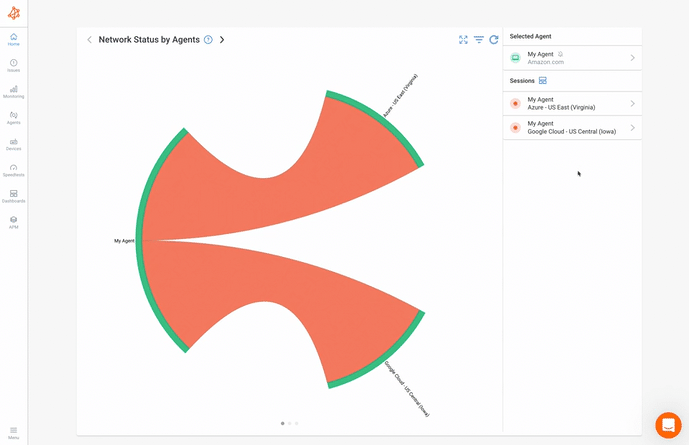
- Obkio is SaaS-based: So it can be deployed in 10 minutes using Obkio’s handy Onboarding Wizard. This means that you can start monitoring network performance quickly, and begin troubleshooting network problems before they affect your users.
- End-to-End: Obkio measures every end of your network, from your LAN to your WAN, using Network Monitoring Agents. Deploy Agents in all your branch offices, remote locations, data centers, Clouds and over the Internet. It can also support all network types.
- Synthetic Monitoring: Obkio measures end-to-end network performance using synthetic UDP traffic, which means there’s no packet capture required and no privacy concerns for users.
With complete visibility, you can proactively pinpoint the source of network problems, whether it's congestion at a specific switch, excessive latency between devices, or inadequate bandwidth within your WAN. This level of insight is indispensable for IT professionals and network administrators striving to maintain optimal WAN performance.

To kickstart your network performance & WAN monitoring journey with Obkio, the first step is to deploy Network Monitoring Agents. These Agents play a vital role as they continuously measure network performance at crucial network points.
They’re deployed in key network locations in your LAN and WAN and continuously exchange synthetic traffic to measure performance.
First, you need to start by deploying Agents in your LAN (Local Area Network). Identify key points within your LAN where you want to monitor network performance, such as your head office, branch offices, data centers and more. Obkio offers a variety of Agent types, all equipped with the same powerful features that can run on various operating systems (e.g., Windows, macOS, Linux), as well as hardware-based Agents.
Next, you’ll need to deploy Monitoring Agents in your WAN as well.
WAN monitoring enables you to oversee network performance from your company's on-site locations (LAN) to distant sites, data centers, cloud services, or branch offices. It equips you with the capability to identify the origins of connectivity issues, whether they arise within your LAN or result from external influences.
WAN monitoring is instrumental in identifying and troubleshooting performance challenges that extend beyond your LAN, including problems associated with internet service providers (ISPs), cloud service providers, or interconnections between branch offices. This streamlined approach expedites the process of diagnosing and resolving issues, contributing to quicker troubleshooting and effective problem resolution.

For this you can use:
- Software or Hardware Agents: Deploy these Agents in remote offices, branch offices or data centers.
- Public Monitoring Agents: These are deployed over the Internet and managed by Obkio. They compare performance up to the Internet and quickly identify if network issues are global or specific to one destination. You can use an AWS or Google Cloud Agent.
Finally, you’ll need to begin monitoring your network devices using Obkio’s Network Device Monitoring feature.
Network devices play a pivotal role in the performance, security, and reliability of a Wide Area Network (WAN). Monitoring network devices is integral to WAN monitoring because it ensures that the devices responsible for routing, securing, and managing traffic within the WAN are functioning optimally. It allows for proactive troubleshooting, performance optimization, and security enforcement, all of which contribute to the overall health and efficiency of the WAN.
1. How to Monitor WAN Network Devices:
Once you’ve installed your monitoring agents, you can then start monitoring your network devices using SNMP by adding the devices inside the Obkio App. The device must support SNMP. Obkio supports all versions of SNMP (v1, v2c and v3) and of course, read-only access is needed. Learn more about the supported devices here.

2. Which WAN Network Devices to Monitor:
For effective WAN monitoring, you should monitor a range of network devices that play critical roles in managing and facilitating network traffic across your Wide Area Network (WAN). The specific devices to monitor may vary based on your network architecture and requirements, but here is a list of common network devices to consider monitoring:
- Routers: Routers are a central part of WANs, responsible for forwarding data between different networks. Monitor routers for performance, traffic flow, and potential issues.
- Switches: Switches manage local network traffic within LANs and are often used in conjunction with routers. Monitor switches to ensure efficient data transmission within LANs.
- Firewalls: Firewalls are crucial for network security. Monitor them for intrusion attempts, rule violations, and security events.
- Load Balancers: Load balancers distribute network traffic across multiple servers or resources to optimize performance. Monitor load balancers for effective load distribution and health of resources.
- Proxy Servers: Proxy servers can be used for caching and security. Monitor proxy servers for response times, caching efficiency, and security issues.
- Network Access Points (NAPs): NAPs are where ISPs connect to your network. Monitor NAPs for bandwidth usage and performance to ensure efficient connections to the internet.
- VoIP Gateways: If your organization uses Voice over Internet Protocol (VoIP), monitor VoIP gateways for call quality, latency, and jitter.
- Wireless Access Points (APs): If your WAN includes wireless components, monitor APs for signal strength, user connections, and security.
- Virtual Private Network (VPN) Appliances: VPN appliances facilitate secure remote access. Monitor VPN appliances for connectivity, security, and performance.
- Cloud Services Gateways: If your organization uses cloud services, monitor cloud services gateways to ensure efficient and secure connections to the cloud.
- Intrusion Detection and Prevention Systems (IDPS): IDPS devices monitor network traffic for suspicious or malicious activity. Monitor IDPS devices for potential security threats.
- Network Load Monitoring Devices: These devices measure the load on the network infrastructure. They help in optimizing traffic routing and balancing.
- WAN Optimization Controllers: WAN optimization devices help improve the efficiency of WAN traffic. Monitoring them ensures that optimization strategies are effective.
- Distributed Denial of Service (DDoS) Mitigation Devices: If your organization is vulnerable to DDoS attacks, monitoring DDoS mitigation devices can help in detecting and mitigating attacks.
- Quality of Service (QoS) Appliances: QoS appliances enforce QoS policies to prioritize certain types of network traffic. Monitor these devices to ensure policy adherence and efficient traffic management.
The specific devices you monitor may depend on the size and complexity of your WAN, as well as the critical applications and services your organization relies on. A comprehensive approach to WAN monitoring involves tracking these devices for performance, security, and compliance to maintain the reliability and efficiency of your network.
After implementing your Network Performance Monitoring tool, Obkio's Monitoring Agents initiate data exchange to assess various network metrics, including jitter, packet loss, and latency. These metrics are then displayed on Obkio's Network Response Time Graph for visualization and in-depth analysis.
By measuring these network metrics, you can promptly identify and locate any degradation in network performance, potentially serving as an early indication of impending network issues. Obkio provides real-time updates on network performance every minute, ensuring that you remain well-informed and receive immediate alerts when issues arise. Furthermore, you have the ability to review historical performance data, which greatly assists in troubleshooting past network problems.
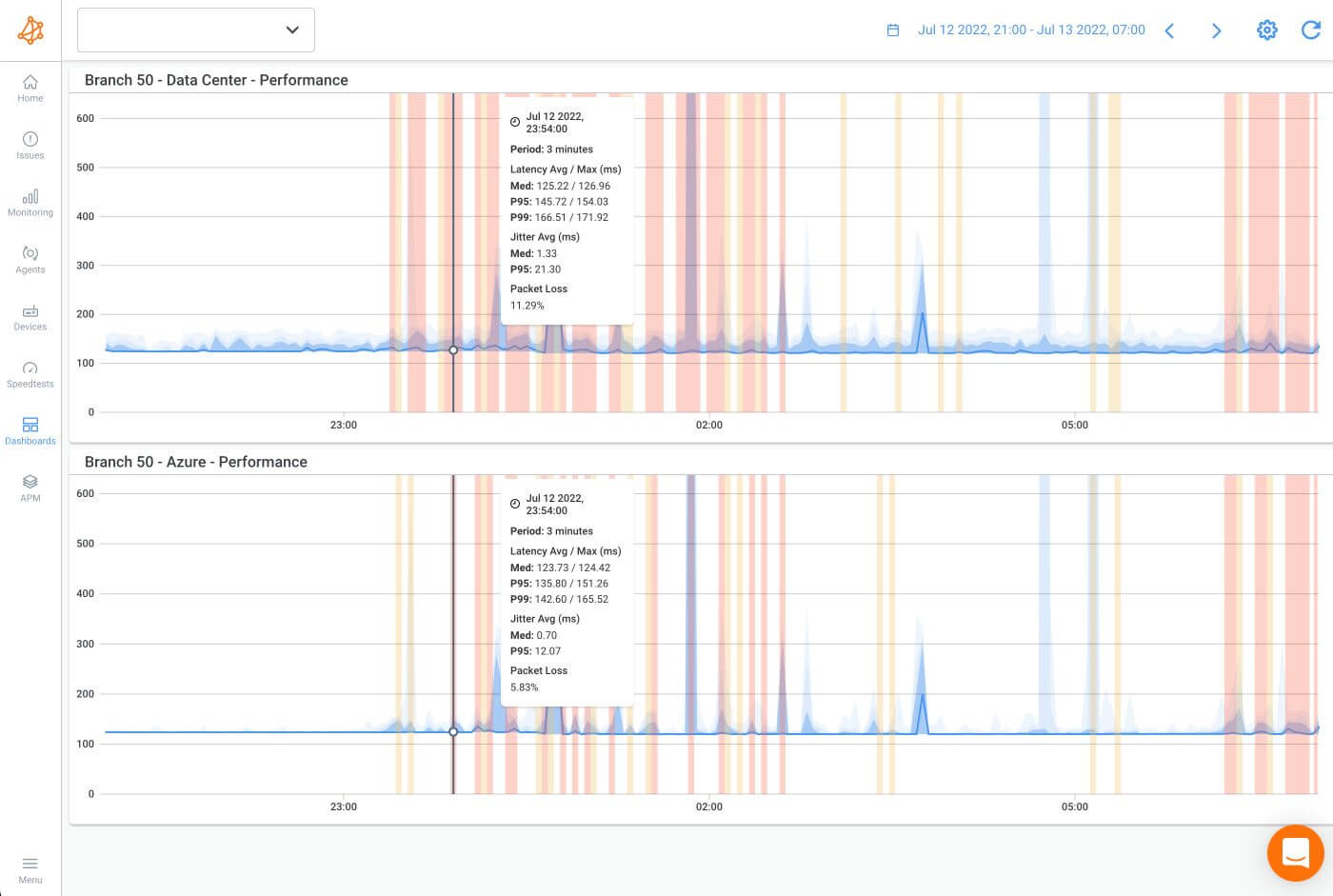

When it comes to monitoring your Wide Area Network (WAN), a strategic approach is vital. It's not feasible nor necessary to monitor every single aspect of your network with equal intensity. Instead, it's important to prioritize what to monitor based on your organization's goals, the criticality of specific network segments, and the nature of the applications and services you rely on.
Here, we explore what parts of your WAN you should prioritize for monitoring and the reasons behind those choices.
WAN entry and exit points, typically where your network connects to the internet or external networks, are crucial to monitor. They are often the first and last points of contact for data entering or exiting your network. Monitoring these points allows you to track traffic entering and leaving your network, which is essential for security, compliance, and understanding the overall health of your WAN.
Your core network, including routers and switches, is the backbone of your WAN. These devices route traffic between various network segments. Monitoring the core network helps identify potential bottlenecks, and performance issues, and ensures efficient data transmission.
If your organization has multiple branch offices, monitoring their connectivity to the central network hub is crucial. Issues at branch offices can impact the experience of remote users and the performance of location-specific applications. By monitoring these connections, you can ensure that branch offices are seamlessly integrated into your network.
With the increasing adoption of cloud services, monitoring connections to cloud providers is essential. It allows you to assess the performance of cloud-based applications, track data transfer, and ensure your organization is getting the expected service quality from cloud vendors.
Data centers are often the heart of an organization's IT infrastructure. Monitoring connections to data centers ensures the performance and availability of mission-critical applications, as well as data storage and retrieval. This is especially important for businesses with centralized data storage and processing.
For organizations with remote workers or multiple locations, monitoring VPNs and remote access points is essential. It helps ensure that remote users have secure and reliable access to corporate resources. Monitoring can also identify and resolve issues affecting remote productivity.
If your WAN relies on Quality of Service (QoS) policies to prioritize certain types of traffic, it's important to monitor QoS points. This ensures that QoS rules are effectively applied and that high-priority applications receive the necessary network resources.
Security devices such as firewalls, intrusion detection systems, and antivirus gateways play a critical role in protecting your network. Monitoring these devices helps identify potential threats, intrusions, and security incidents in real-time.
Load balancers and traffic distribution points ensure that network traffic is efficiently distributed among servers and resources. Monitoring these points helps maintain load balancing efficiency and prevents the overloading of specific resources.
In summary, prioritizing what to monitor in your WAN is essential for efficient network management. It allows you to focus on critical areas, identify potential issues before they escalate, and ensure that your WAN supports the needs of your organization effectively.
Monitoring both your WAN (Wide Area Network) and LAN (Local Area Network) is crucial for comprehensive network management and efficient WAN monitoring. Many organizations have hybrid networks that include a combination of on-premises LANs and cloud-based services connected via the WAN. Monitoring both segments is essential to maintain a consistent user experience and ensure seamless integration of cloud services into your network.
Monitoring both the WAN and LAN provides a holistic view of your network infrastructure. This visibility extends from your organization's premises, through the LAN, and across the WAN to remote locations, data centers, and cloud services. It allows you to track network performance from the point where data originates to its final destination, ensuring end-to-end visibility.
Network issues can occur within the LAN or the WAN. By monitoring both, you can quickly identify the source of a problem. If performance issues are localized to the LAN, LAN monitoring helps you diagnose and resolve the issue within your internal network. If the issue is WAN-related, WAN monitoring assists in pinpointing external factors contributing to the problem.
Master LAN Monitoring: Learn the essentials, best practices, and improve LAN network performance with Obkio's Network Performance Monitoring tool.
Learn more

Understanding the key components of WAN performance is fundamental for effective network management. Your network serves as the backbone of your organization, linking users, services, and data across distances. To ensure its reliability and efficiency, it's essential to explore the core elements that shape WAN performance.
Let’s look into the critical metrics defining WAN performance, including bandwidth, latency, and jitter, which serve as the foundation for your network's functionality. Continuous monitoring, facilitated by Network Performance Monitoring tools like Obkio, allows you to measure and analyze these metrics, empowering you to optimize network performance and swiftly address issues.
By comprehending these essential network metrics and their practical implications, you'll be well-equipped to navigate the complex terrain of WAN performance, ensuring a robust and responsive network for your organization.
Bandwidth:
Bandwidth refers to the capacity of your network to transmit data. It is typically measured in bits per second (bps), with common units being kilobits per second (Kbps), megabits per second (Mbps), or gigabits per second (Gbps).
Bandwidth represents how much data can be transmitted over your network in a given time frame. It's essential to monitor bandwidth to ensure that your network can handle the data volume required for various applications and services. Insufficient bandwidth can lead to slow data transfer and a poor user experience.
Latency:
Latency, often referred to as ping, is the time it takes for data to travel from the source to the destination and back. It is measured in milliseconds (ms). Low latency is desirable, especially for real-time applications like video conferencing and online gaming, as it ensures minimal delays in data transmission. High latency can lead to delays, buffering, and poor application performance.
Jitter:
Jitter is the variation in latency between data packets as they travel across the network. It is also measured in milliseconds. Consistent, low jitter is essential for real-time applications to maintain smooth data flow. High jitter can cause erratic delays and negatively impact the quality of real-time communication. Monitoring jitter helps ensure a stable and reliable network for these applications.
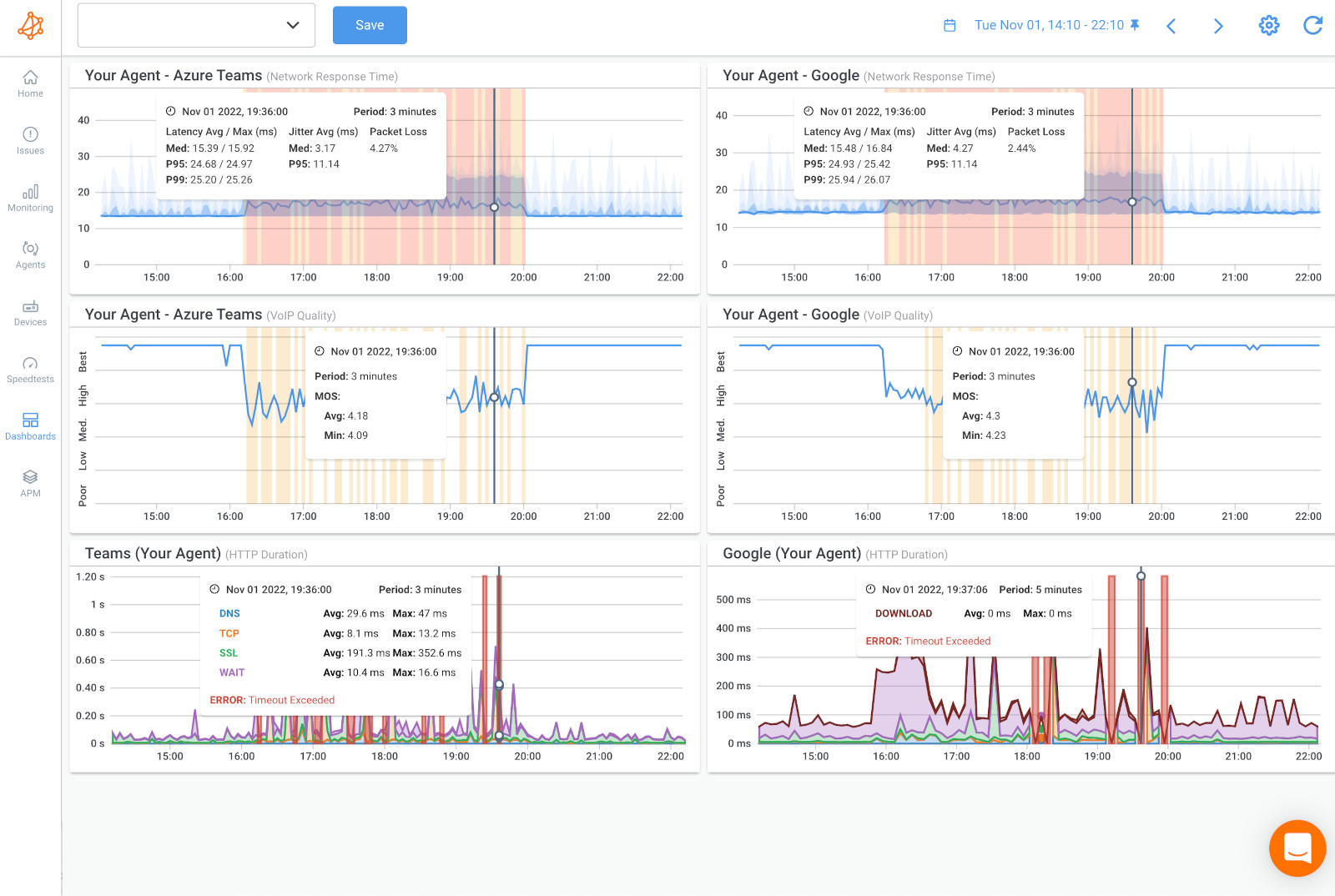
Packet Loss:
Packet loss refers to the percentage of data packets that fail to reach their destination. It can result from network congestion, hardware failures, or other issues. Monitoring packet loss is critical because excessive packet loss can lead to data retransmission, increased latency, and a degradation in network performance.
Throughput:
Throughput is the actual data transfer rate on the network and is often measured in bits per second. It represents the effective data transmission speed, accounting for factors like bandwidth, packet loss, and latency. Monitoring throughput helps you assess the real-world performance of your network.
Round-Trip Time (RTT):
RTT is the time it takes for a data packet to travel from the source to the destination and back. It's often measured in milliseconds. RTT is closely related to latency but provides a comprehensive view of the total time for a round trip. WAN RTT monitoring helps identify delays in network communication.
Application Performance:
Application-specific metrics are crucial for monitoring WAN performance, especially for mission-critical applications. These metrics may include page load times for web applications, VoIP call quality, or response times for database queries. By monitoring application performance, you can ensure that essential services run smoothly and meet user expectations.
Service Availability:
Monitoring service availability involves tracking the uptime and downtime of critical network services, such as email servers, web services, and cloud applications. Service availability metrics help identify and address service interruptions promptly.
Understanding the anatomy of WAN performance involves monitoring critical metrics like bandwidth, latency, jitter, packet loss, throughput, RTT, application performance, network availability, and security events. These metrics provide valuable insights into your network's health and performance, enabling you to optimize performance, troubleshoot issues, and ensure a secure and reliable network environment.
Learn how to measure network performance with key network metrics like throughput, latency, packet loss, jitter, packet reordering and more!
Learn more

Now that we've explored the ins and outs of WAN performance, it's time to roll up our sleeves and talk strategy. This chapter dives into the nitty-gritty of what it takes to master WAN monitoring.
Effective WAN monitoring isn't just about having the right tools; it's about how you use them. We'll cover the must-dos, like setting clear monitoring objectives that align with your network goals. Plus, we'll dig into the art of alerts and notifications – when to sound the alarm and who gets the call.
But that's not all; we'll unveil the hidden gem of historical data. It's like having a time machine for your network, helping you spot trends, diagnose issues, and learn from the past.
Effective WAN monitoring begins with a clear understanding of your monitoring objectives. Defining these objectives is critical for focusing your monitoring efforts and ensuring that you're tracking the right metrics. Here are some key considerations:
- Performance Goals: Determine the specific performance goals for your network. What level of bandwidth, latency, and jitter is acceptable for your organization? Identifying these goals provides a benchmark for performance measurement.
- Application Prioritization: Understand which applications are mission-critical for your organization. Define the performance requirements and prioritization of these applications, as they may require special attention.
- User Experience: Consider the end-user experience as a monitoring objective. How do network issues impact your users? Defining user-centric objectives helps ensure a positive experience.
- Resource Allocation: Objectives related to resource allocation involve optimizing the use of available network resources. Set goals for bandwidth distribution and traffic prioritization.
Timely detection of network issues is crucial for minimizing downtime and maintaining performance.
Define threshold values for network metrics. When a metric exceeds or falls below a predefined threshold, an alert is triggered. For example, set bandwidth thresholds to detect congestion or latency thresholds for identifying delays. With tools like Obkio's Network Performance Monitoring (NPM) tool, you can not only monitor real-time metrics but also analyze historical data. This historical perspective empowers you to set more informed thresholds based on past network behaviour, enhancing the accuracy of your alerts.
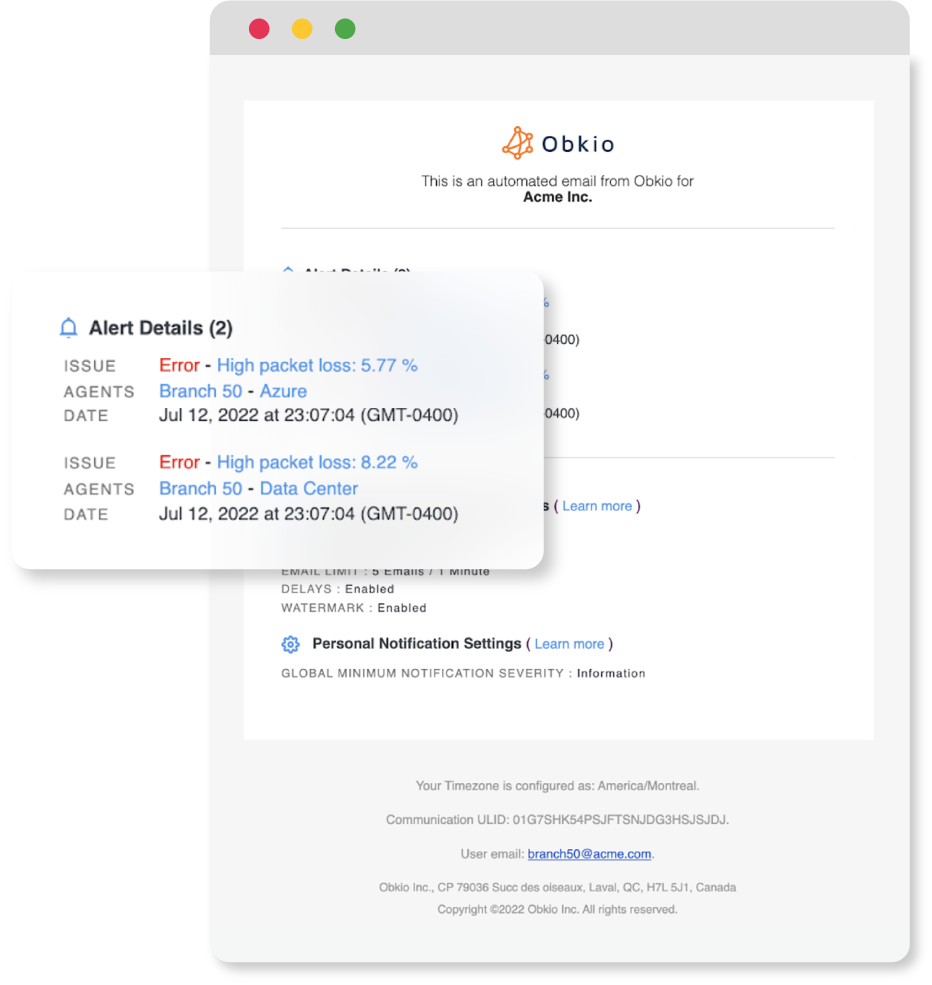
Historical data is a valuable resource for effective WAN monitoring. It provides context, trend analysis, and insights into long-term network performance. Here's why historical data is important:
- Trend Analysis: Historical data allows you to identify trends and patterns in network performance. This helps in proactive capacity planning, issue prediction, and optimization efforts.
- Root Cause Analysis: When network issues occur, historical data enables you to trace back and identify the root causes. It helps in understanding recurring problems and implementing long-term solutions.
- Performance Benchmarking: Historical data serves as a benchmark for measuring performance improvements or degradation over time. It helps in evaluating the impact of network changes.
Effective WAN monitoring is guided by well-defined monitoring practices. By focusing on these network monitoring best practices, organizations can maintain a resilient and high-performing network that aligns with their goals and user expectations.


WANs (Wide Area Networks) are the arteries that connect your organization's remote offices, data centers, and cloud services. They're the digital highways for your data, applications, and communications. However, like any complex infrastructure, WANs can encounter common issues that impact performance and reliability.
In this section, we'll explore some of these common WAN network issues, how to recognize them using WAN monitoring, and effective troubleshooting strategies.
Bandwidth Congestion: One of the most prevalent issues in WANs is bandwidth congestion. When data demand exceeds available bandwidth, it leads to sluggish data transfers, increased latency, and poor application performance. This issue can affect the user experience and productivity.
Latency and Delay: Latency issues result in delays in data transmission. While some latency is inherent in WANs due to the distance data must travel, excessive latency can cause problems for real-time applications like VoIP and video conferencing.
Packet Loss: Packet loss occurs when data packets fail to reach their intended destination. It can lead to data retransmission, which increases latency and affects application performance.
Jitter: Jitter is the variation in latency between data packets. High network or Internet jitter can disrupt the smooth flow of real-time communications, causing audio or video disruptions in VoIP and video conferencing.
Security Threats: WANs are vulnerable to security threats, including malware, intrusion attempts, and data breaches. Identifying and mitigating security threats is critical for network protection.
Application Performance: Poor application performance can result from network issues, leading to slow load times for web applications, call quality problems for VoIP, and performance degradation in other critical applications.
High ISP Latency: If your ISP experiences high latency, it can lead to delays in data transmission. Monitor latency levels using WAN monitoring tools like Obkio. Set alert thresholds for latency, and if they are consistently exceeded, contact your ISP to investigate the issue.
ISP Downtime: Periodic ISP downtime can disrupt your WAN. Set up network monitoring alerts for network outages using WAN monitoring tools. When an outage occurs, your team will be notified promptly, allowing you to switch to a backup ISP or take alternative measures.
ISP Bandwidth Limitations: If your ISP imposes bandwidth caps or throttles your connection, it can limit your network's performance. Regularly monitor bandwidth utilization. If you consistently approach your ISP's limits, consider upgrading to a higher-speed plan or negotiating better terms.
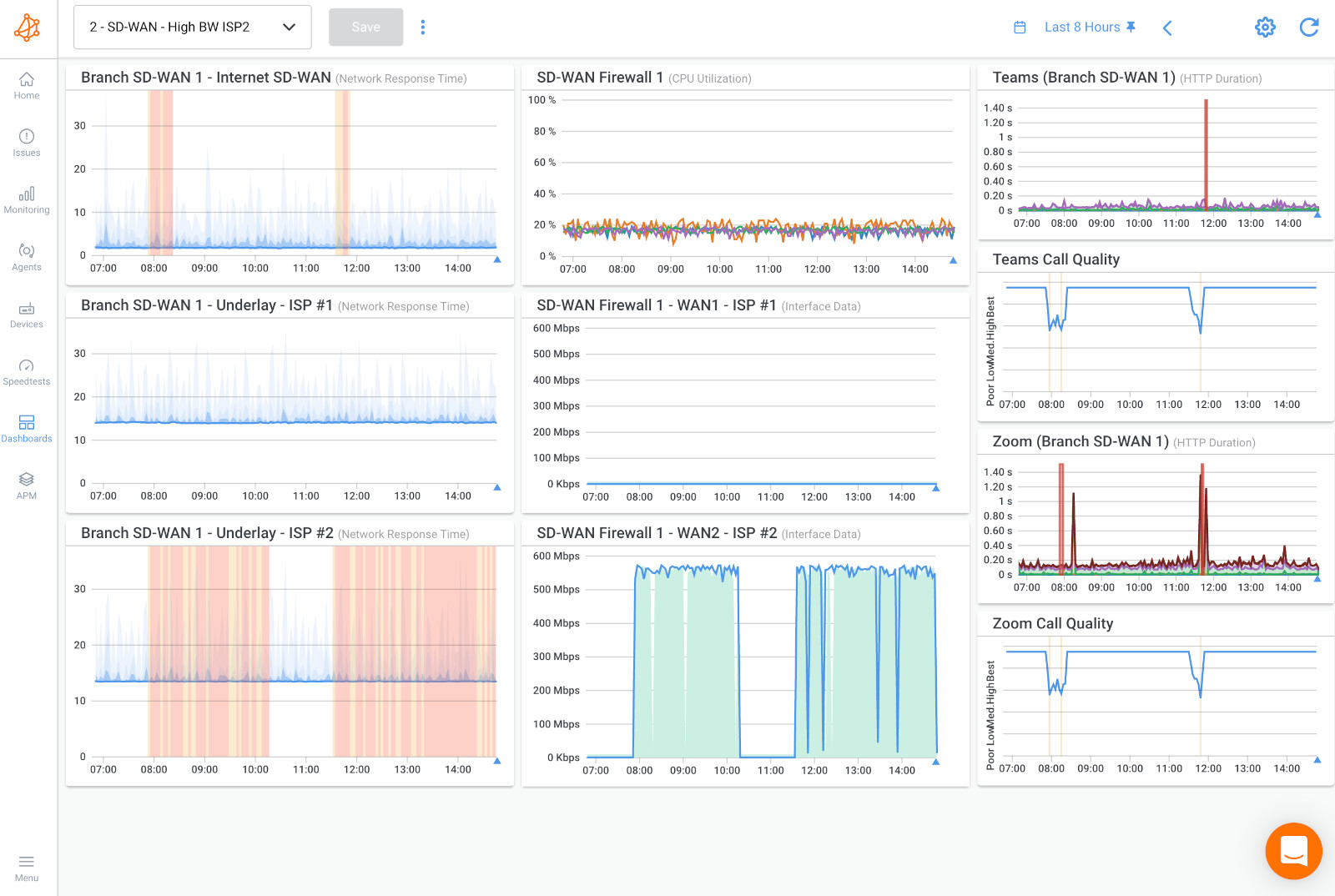
Cloud Service Performance: Slow performance of cloud-based applications or services can impact productivity. Use WAN monitoring tools to measure latency between your network and the cloud service provider. If latency is consistently high, explore options to optimize your cloud service connections, such as choosing a closer data center.
Data Transfer Bottlenecks: When transferring data to or from the cloud, network bottlenecks can occur, leading to slow upload or download speeds. Monitor data transfer rates and identify the bottleneck point in your network. Upgrading hardware or optimizing configurations can often resolve this issue.
Cloud Security Breaches: Security breaches involving cloud services can lead to data leaks and compromise your organization's integrity. Regularly monitor security events with intrusion detection systems and consider implementing security measures, such as firewalls, to protect data in transit to and from the cloud.
Cloud Outages: Cloud service providers occasionally experience network outages, causing service interruptions for your organization. Set up monitoring alerts to be informed of cloud service outages as soon as they occur. Consider implementing a network failover solution to mitigate the impact of such outages.
Network issues within a WAN (Wide Area Network) can occur at various points in the network infrastructure. WAN monitoring tools like Obkio can play a crucial role in identifying and addressing these issues promptly, helping you maintain a high-performing and reliable network environment.
Here are common locations or areas where network issues may manifest:
- LAN Segment: While LANs (Local Area Networks) are typically more controlled environments, issues can still arise within the LAN segment. These issues may include faulty cables, misconfigured switches, or congested subnets.
- WAN Edge: The WAN edge is the demarcation point between the LAN and the external WAN. Problems here could involve issues with the WAN connection, such as a malfunctioning router, a misconfigured firewall, or issues with the service provided by your ISP.
- WAN Backbone: The WAN backbone includes the core network infrastructure that connects various sites and data centers. Network congestion, hardware failures, or routing problems in this area can lead to performance issues.
- Internet Connectivity: WANs often rely on the Internet to connect remote sites, access cloud services, or communicate with other organizations. Internet-related issues include ISP problems, peering issues, or general internet congestion.
- Remote Offices/Branches: Remote offices or branch locations are susceptible to issues related to their local network infrastructure, such as LAN problems, router issues, or even ISP-related issues if they have a separate internet connection.
- Cloud Service Providers: If your organization utilizes cloud services, issues can arise within the cloud service provider's infrastructure, affecting your connectivity and service performance.
- Third-Party Connections: WANs may also involve connections to third-party organizations or partners. Issues related to these connections can occur on either end, impacting communication.
- Security Incidents: Security issues like data breaches, malware infections, or intrusion attempts can affect network performance, particularly if they result in network congestion or data loss.
Identifying the specific location of a network issue is a critical step in troubleshooting and resolving the problem. WAN monitoring, along with tools like traceroute or network diagnostic utilities, can help pinpoint the source of the issue and expedite the troubleshooting process.
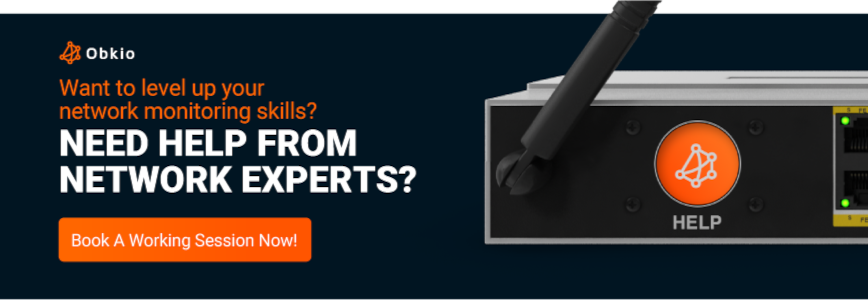
WAN links are the vital arteries of data flow in your organization's dispersed network. These connections, whether over leased lines, the internet, or private networks, underpin the seamless exchange of information.
To monitor WAN links effectively, you can leverage a Network Performance Monitoring (NPM) tool like Obkio. By following the same steps we've already described in this article, you can ensure that your WAN links are performing at their best and are protected against potential issues.
WAN (Wide Area Network) links are the connections that allow data to flow between geographically dispersed locations, such as branch offices, data centers, cloud services, and remote users. These links can take various forms, including:
- Leased Lines: Dedicated point-to-point connections, like T1 or T3 lines.
- Internet Connections: WAN links can leverage the public internet to connect locations, typically using technologies like DSL, cable, or fibre optics.
- MPLS (Multiprotocol Label Switching): Private networks, like MPLS networks, offered by service providers for secure and efficient data transfer.
- Satellite Links: Connections via satellite for remote and rural areas.
- Wireless Links: Connections using wireless technologies like Wi-Fi, cellular networks, and point-to-point microwave links.
- Virtual Private Networks (VPNs): Encrypted connections over the internet or public networks, offering secure communication between locations.
These WAN links serve as the digital highways connecting your organization's dispersed sites, ensuring seamless data exchange and access to centralized resources.
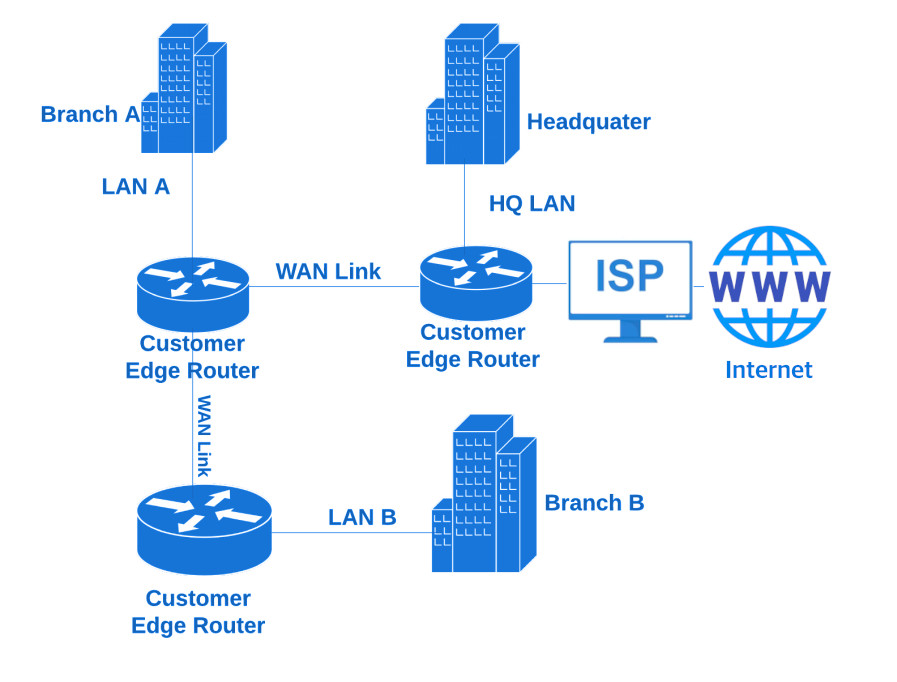
Monitoring WAN links is imperative for several critical reasons. WAN link monitoring enables you to ensure that your network operates at its best, providing users with fast and reliable access to applications, data, and services. By tracking metrics like bandwidth usage, latency, jitter, and packet loss, you can identify performance bottlenecks and optimize network resources.
Monitoring WAN links is also essential for detecting security threats and unusual network activity. Intrusion attempts, malware infections, and data breaches can have a significant impact on network performance. Monitoring helps you identify and respond to security incidents quickly.
To ensure optimal performance for critical applications, you can implement QoS and traffic-shaping strategies. WAN link monitoring is crucial for verifying the effectiveness of these strategies and making necessary adjustments.
In summary, monitoring WAN links is a proactive approach to maintaining network performance, reliability, and security. It allows you to optimize resources, detect and resolve issues, secure your network, and plan for future growth effectively. Whether your organization relies on traditional leased lines or cloud-based VPNs, WAN link monitoring is a fundamental practice for ensuring the seamless flow of data across your geographically dispersed network.
Wide Area Networks (WANs) often rely on external service providers, such as Internet Service Providers (ISPs) or Cloud Service Providers, to establish connections between remote sites and data centers. These external connections are typically governed by Service Level Agreements (SLAs), which define the agreed-upon terms and conditions of service, including performance guarantees.
WAN monitoring plays a crucial role in managing these SLAs and monitoring your relationships with ISPs. It allows you to track the network's performance and ensure that your service providers meet their obligations. Here's how WAN monitoring contributes to SLA and ISP management:
Real-Time Monitoring: WAN monitoring provides real-time data on critical network metrics, such as latency, jitter, and packet loss. By continuously tracking these metrics, you can quickly identify deviations from the expected performance.
ISP Issues Alerts & Thresholds: You can set alert thresholds for these key metrics. When any metric exceeds the predefined threshold, it triggers an alert. This immediate notification enables rapid issue detection, especially when ISP-related issues, such as increased latency or packet loss, occur.
Identify ISP Issues: WAN monitoring tools help you isolate the source of ISP issues. When you detect performance issues, you can analyze the data to determine whether they originate from your internal network or external ISP connections.
Historical Data: Monitoring tools store historical data, enabling you to identify patterns and recurring issues. If you observe consistent ISP-related problems at specific times or on specific days, it can point to issues with your service provider.
SLA Benchmarking Performance: WAN monitoring allows you to establish benchmarks for network performance when your ISP delivers optimal service. Comparing current performance to these benchmarks helps you identify discrepancies and holds ISPs accountable for SLA compliance.
SLA Performance Validation: WAN monitoring helps validate whether your ISP is meeting the performance guarantees defined in your SLA. By continuously tracking metrics, you can gather empirical evidence of compliance or deviations.
Data for SLA Reporting: The data collected through WAN monitoring serves as the basis for SLA reporting. You can generate reports that demonstrate network performance over time, which is essential for SLA audits and negotiations with your service providers.
Evidence for Disputes: In cases of SLA disputes or disagreements with service providers, historical data from WAN monitoring serves as evidence. It can be used to substantiate claims of non-compliance and support discussions for issue resolution.
Proactive SLA Management: With WAN monitoring, you can proactively manage SLAs by addressing potential issues before they become severe. Early issue detection allows you to engage with your service provider and request corrective actions if needed.
WAN monitoring is a cornerstone of effective SLA and ISP management. It empowers organizations to validate the performance of their service providers, promptly identify and troubleshoot ISP-related issues, and maintain a strong position in SLA negotiations and compliance.
With data-driven insights from WAN monitoring, you can ensure that your external connections meet the agreed-upon performance standards and your network operates at its best.
Learn about SLA monitoring & reporting using Network Monitoring to measure network, service performance, user experience & understand if SLAs are being met.
Learn more

Your WAN is the heartbeat of data flow within your organization. It's where the performance symphony plays out, and every note matters - but countless factors affect performance. From bandwidth limitations to security concerns, understanding these variables is vital.
But the real magic happens when you wield the power of WAN monitoring. Let’s explore the role of WAN monitoring in optimization, and the art of implementing Quality of Service (QoS) and traffic shaping for peak network performance.
Get ready to fine-tune your WAN connections, aligning it perfectly with your organization's needs and your users' expectations.
Quality of Service (QoS) and traffic shaping are essential techniques for optimizing WAN performance. Here's how they work:
- QoS: QoS involves classifying network traffic into priority levels and applying policies to ensure that high-priority traffic receives preferential treatment. By implementing QoS rules, you can prioritize critical applications and allocate network resources effectively.
- Traffic Shaping: Traffic shaping involves controlling the flow of traffic to prevent congestion and ensure equitable distribution of bandwidth. It smooths out traffic peaks and troughs, optimizing network performance and enhancing user experience.
By leveraging WAN monitoring to identify performance bottlenecks and areas of improvement, you can implement QoS and traffic shaping strategies effectively. These techniques help in optimizing network performance, prioritizing critical applications, and ensuring efficient bandwidth utilization.

- Optimize Network Configuration: Regularly review and optimize network configurations to eliminate bottlenecks, inefficiencies, and security vulnerabilities. Ensure that routing and firewall rules are well-designed.
- Cloud Service Optimization: If your organization uses cloud services, optimize connections to cloud providers by selecting the closest data centers and utilizing dedicated or low-latency connections.
- Data Compression and Deduplication: Implement data compression and deduplication techniques to reduce the amount of data transmitted over the WAN, effectively utilizing available bandwidth.
- Load Balancing: Distribute network traffic evenly across multiple WAN links or connections to optimize performance and provide redundancy.
By following these monitoring and optimization tips, you can ensure that your WAN connection is both well-monitored and optimized for the best performance and reliability, meeting the needs of your organization and users.
In this extensive exploration of Wide Area Network (WAN) monitoring, we've illuminated the critical importance of overseeing the intricate web of data flows that connect your geographically dispersed sites. From understanding key performance metrics to diagnosing and resolving common WAN issues and optimizing your network, we've traversed the WAN landscape.
As we bring this journey to a close, we want to leave you with a clear roadmap to harness the full potential of your WAN's performance using Obkio's Network Performance Monitoring (NPM) tool.

- Assess Your WAN Monitoring Needs: Evaluate your organization's specific monitoring objectives, whether it's optimizing performance, ensuring security, or complying with SLAs.
- Select Obkio's NPM Tool: Embrace Obkio's Network Performance Monitoring tool as your go-to solution. Its real-time insights and historical data analysis capabilities will be your guiding light.
- Define Key Metrics: Determine the critical metrics you'll monitor using Obkio. Bandwidth usage, latency, jitter, and packet loss should be your primary focus.
- Set Alert Thresholds: Configure alert thresholds for these key metrics. Obkio's alerting system will keep you informed when performance deviates from expected norms.
- Monitor in Real-Time: Continuously observe real-time data provided by Obkio to spot trends and detect issues as they happen.
- Analyze Historical Data: Leverage historical data stored by Obkio to identify patterns, recurring issues, and performance trends.
With this roadmap, you're well-equipped to supercharge your WAN performance and fine-tune your network for peak efficiency. Obkio's NPM tool will be your guiding light, ensuring that your WAN isn't just a network but a finely tuned instrument of productivity and reliability.



























 Obkio Blog
Obkio Blog



